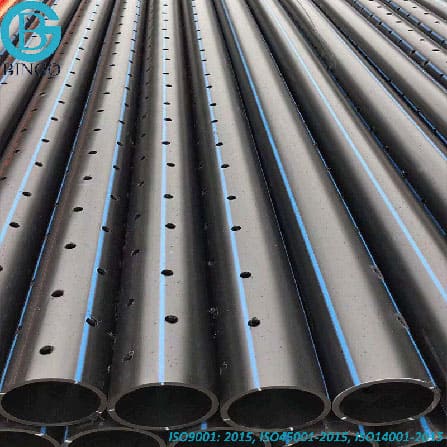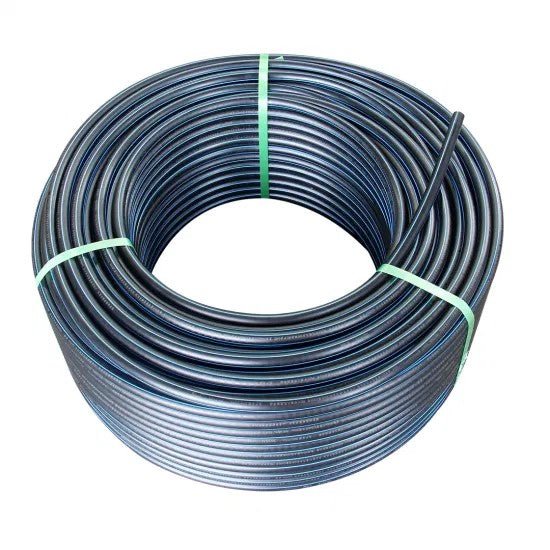The Necessary Steps for Effective Installation of HDPE Pipeline in Your Following Job
Successful setup of HDPE pipe requires careful preparation and implementation. Key actions include reviewing job needs, preparing the website, and selecting correct joining techniques. Each stage plays a critical duty in ensuring the honesty and efficiency of the pipe. Understanding these essential actions can greatly affect the general success of the task - Pipe Supplier American Plastics Midland. The nuances of each step might hold the secret to getting over common obstacles faced during setup.
Understanding the Advantages of HDPE Pipeline
High-density polyethylene (HDPE) pipeline provides countless advantages that make it a recommended choice for different applications. Its high resistance to deterioration and chemicals guarantees toughness in demanding settings, greatly prolonging the life-span of installations. In addition, HDPE's flexibility enables easier installation, specifically in difficult surfaces, as it can bend without breaking. The lightweight nature of HDPE pipe streamlines transport and handling, lowering labor costs during installation.
Moreover, HDPE pipeline is known for its low friction coefficient, which improves fluid circulation and decreases energy usage. Its seamless construction decreases the threat of leakages, contributing to better resource monitoring and environmental management. On top of that, HDPE is recyclable, lining up with sustainable techniques and decreasing ecological influence. In general, the combination of stamina, flexibility, and eco-friendliness makes HDPE pipe a premium selection for a vast array of jobs, from water distribution to industrial applications.
Preparation Your HDPE Pipe Installment
When intending an installation of HDPE pipeline, mindful factor to consider of several crucial aspects is vital to protect an effective project. Initially, job managers must analyze the specific needs of the pipeline, including the planned use, circulation prices, and environmental problems. Understanding these criteria will certainly assist the selection of proper pipe measurements and product quality.
Next, timelines ought to be established, considering procurement timetables and any type of potential hold-ups. Sychronisation with neighborhood authorities for permits and governing conformity is also important. In addition, an in-depth budget plan must be prepared, incorporating all prices connected with materials, labor, and machinery.
It is essential to involve a certified team experienced in HDPE pipe installation. Their knowledge will assist mitigate dangers, assurance adherence to sector standards, and eventually add to the task's success. Complete planning lays the foundation for a smooth installment process and lasting efficiency of the HDPE piping system.
Preparing the Site for Installation
Proper website prep work is vital for the successful setup of HDPE pipe. Before installment begins, the website should be extensively analyzed to assure it fulfills all needed needs. This includes surveying the ground for existing structures, utilities, and possible hazards that could impede the installation procedure.

Proper altitude and positioning must be established to preserve a consistent slope for water drainage objectives. Correct water drainage around the setup website is additionally imperative to protect against water buildup, which can result in complications down the line.
Techniques for Signing Up With HDPE Pipelines
Attaining a dependable connection between HDPE pipelines is essential for making certain the honesty and durability of the installation. Numerous techniques exist for signing up with these pipelines, each suited for various job requirements. Blend welding is just one of the most usual methods, utilizing heat to bond the pipe finishes with each other, developing a seamless and durable link. This strategy can be more categorized right into socket blend and butt fusion, relying on the pipeline setups.
Mechanical installations are another choice, employing clamps and threaded ports to sign up with sections of HDPE pipeline. While generally faster to set up, they may need added maintenance gradually. Electrofusion is a specialized approach that involves utilizing electric current to heat and fuse the pipelines with specifically developed fittings, making certain a solid bond. Picking the proper signing up with strategy is important, as it directly affects the general performance and reliability of the HDPE piping system in the desired application.
Checking and Evaluation of Installed Pipeline
The testing and examination of set up HDPE pipes are critical to guaranteeing their performance and longevity. This process encompasses aesthetic inspection methods, stress testing methods, and leakage detection procedures to recognize possible issues. By employing these methods, specialists can confirm the honesty of the installment prior to it is placed right into usage.
Visual Inspection Techniques
Employing reliable aesthetic assessment techniques is essential for guaranteeing the stability of set up HDPE pipes. Examiners should systematically examine all noticeable areas of the pipeline to determine any type of indicators of damage, misalignment, or incorrect installment. Trick indicators to evaluate consist of joint stability, surface area irregularities, and connections. Inspectors may utilize devices such as multiplying glasses or video cameras to boost exposure and detail. It is vital to examine for indications of environmental stress, such as bending or extreme flexing, which could endanger efficiency. Consistent documentation of findings permits tracking adjustments over time and helps guide necessary repair services. By sticking to established visual evaluation procedures, job teams can notably decrease the danger of future failures and ensure long-lasting dependability of the piping system.
Stress Evaluating Techniques
Aesthetic evaluation acts as an initial action, yet it is not adequate on its own to guarantee the efficiency of set up HDPE pipes. Pressure testing methods are essential for ensuring the stability of these systems. Commonly, hydrostatic testing is used, where the pipes are loaded with water and based on pressure degrees above the desired operating pressure. This approach assists identify weak points or potential leakages. Pneumatic screening can likewise be utilized, although it carries better risks due to the compressibility of air. Despite the approach chosen, adhering to market requirements and safety procedures is important. After carrying out pressure tests, comprehensive documents is needed to validate the outcomes and confirm that the installation fulfills all operational needs prior to continuing to the following stage of the task.

Leak Detection Treatments
Just how can one assure that mounted HDPE pipelines are devoid of leakages? Reliable leakage discovery treatments are essential to safeguard the honesty of the system. Aesthetic evaluations must be done, looking for indications of water buildup or dirt disintegration around pipeline joints. Following this, pressure screening can stainless steel plumbing fittings verify the system's strength. A typical approach is the hydrostatic test, where water is introduced under pressure, checking for decreases that show possible leaks. In addition, advanced modern technologies, such as acoustic sensing units or infrared thermography, can detect leaks that might not be visible. Normal tracking and maintenance additional add to the durability of HDPE pipelines, guaranteeing they stay leak-free throughout their functional life-span. Appropriate documentation of these treatments is essential for compliance and future reference.
Maintenance Tips for Long-Term Efficiency
To ensure the long life of HDPE pipelines, developing a regular evaluation routine is important. This positive technique permits the early detection of prospective problems, minimizing expensive repair work. In addition, carrying out appropriate cleansing strategies will certainly assist keep peak performance and protect against accumulation that can influence functionality.
Regular Evaluation Set Up
HDPE pipelines are known for their durability and resistance to rust, establishing a routine examination routine is important Get the facts for ensuring their lasting efficiency. Regular examinations assist determine prospective problems such as leakages, joint integrity, and ecological influences that may impact the pipeline's functionality. It is suggested that inspections take place at least biannually, or extra regularly in atmospheres with severe conditions. hdpe pipe fittings Midland TX. Throughout these analyses, visual checks ought to be performed to spot indications of wear or damages. In addition, using technology such as ultrasonic testing can give further insights right into the pipe's condition. By applying a structured assessment timetable, project managers can proactively deal with issues, consequently extending the life-span of HDPE pipelines and maintaining system effectiveness
Appropriate Cleaning Techniques
Proper cleaning methods play a crucial function in preserving the long-term performance of HDPE pipes. Regular cleaning prevents the buildup of particles, debris, and biofilm, which can cause blockages and lowered flow efficiency. Operators must utilize methods such as high-pressure water jetting or foam cleaning to successfully eliminate pollutants without damaging the pipeline surface. It is crucial to prevent using harsh chemicals that might break down HDPE material. In addition, set up upkeep checks must include visual inspections for any type of signs of wear or damage. Properly educated workers should execute these cleansing procedures, making sure compliance with security and environmental guidelines. By executing these practices, the life-span of HDPE pipelines can be significantly prolonged, making certain suitable performance throughout their functional life.
Often Asked Questions
What Are the Ecological Influences of HDPE Pipeline Production?
The ecological effects of HDPE pipeline production include greenhouse gas exhausts, energy intake during production, potential plastic air pollution, and challenges in recycling. HDPE's durability and resistance to corrosion can reduce some ecological issues.
Exactly How Does HDPE Pipeline Contrast to Other Materials?

What Tools Are Needed for HDPE Pipeline Setup?
Vital devices for HDPE pipe setup consist of a fusion maker, pipeline cutters, shovels, measuring tape, and security equipment. Appropriate tools guarantees efficient, secure handling and installment, adding to the project's general success and stability.
Exist Any Kind Of Specific Laws for HDPE Pipeline Setup?
Certain regulations for HDPE pipe installation vary by region, usually regulated by neighborhood, state, or federal codes. Conformity with these laws assurances safety and security, ecological security, and capability, making adherence essential for successful project results.
Can HDPE Pipeline Be Recycled After Use?
Yes, HDPE pipes can be reused after usage. Their polycarbonate nature permits reprocessing, making them ideal for reusing right into new products. This sustainability aspect contributes to ecological preservation and advertises circular economic situation techniques in building.